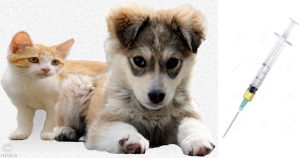Panleukopenia In Your Cat – Feline Distemper
What You Should Know About It (aka FPLV, FPV, FP, Feline Parvovirus)
Ron Hines DVM PhD

Feline Distemper (panleukopenia) is a disease American cat owners often hear or read about, but rarely encounter. That was not always the case. Years ago panleukopenia was the leading cause of death of immature and young adult cats. That ended in the 1950s when very effective, long lasting vaccine to protect your cat became available. But the panleukopenia virus is still around. It is still a significant problem in animal shelters, feral cat colonies and in areas of the world where cats are not routinely vaccinated. Pan mean all, leuko stands for white blood cells and penia means lacking. This virus is so lethal to cats because it destroys their ability to produce protective white blood cells in their bone marrow and lymph nodes.
Dog parvovirus and feline panleukopenia virus (aka “feline distemper“) are different but closely related virus. Both these virus attack cells that are dividing rapidly – like the cells of your cat’s bone marrow and the cells that line its intestines. With a deficiency of those defensive blood cells and a compromised, ulcerated intestinal lining, diarrhea, intestinal bleeding, dehydration and susceptibility to secondary bacterial infections result. The current panleukopenia virus is not a threat to humans and probably not a significant threat to dogs either. (read here) The virus will readily infect raccoons and all of our domestic cat’s relatives found in zoos and in the wild, perhaps ferrets and mink as well. During infection, the virus is shed in large numbers through the liquids in feces and all other body fluids. Once a cat has succumbed or recovered from this virus in a particular location, the virus often lurks there for extended periods awaiting the arrival of another unvaccinated, susceptible cat.
Most older, unvaccinated, outdoor or group-housed cats are survivors of panleukopenia and are no longer able to contract it. The virus produces a solid, long lasting immunity. It is the younger unvaccinated cats and kittens that are at risk. Because somewhat more kittens arrive in the spring and summer and mature through the early fall, that is the time when spikes in panleukopenia cases most commonly occur.
How Would My Cat Catch Panleukopenia?
I mentioned that the Feline Panleukopenia virus is a very contagious virus and that loose, watery stools and to a lesser extent vomit from infected sick cats fill the immediate environment with an enormous number of infective virus particles. These can persist in that environment for a very long time – particularly if the location is damp, shaded or porous. Panleukopenia virus do not readily move through the air or transfer from cat to cat through mosquito, flea or tick bites. They can however be carried from place to place by humans on contaminated objects, your hands clothes and shoes.
Most kittens under 11 weeks of age have some residual protection against the panleukopenia and other viruses due to the temporary immunity passed to them through their mother’s milk. That is because the first-milk of all mothers (colostrum) contains the antibodies of their mother as well as other protective elements. (read here & here) That is the case if the mother cat was previously exposed to the virus or vaccinated. But after that time and until about 16 weeks of age when their immune system is fully functional, up to three-forth of them will die if exposed to the virus. As the kittens get older, the fatality rate drops due to their increased body reserves to weather the infection as well as their increased body mass to weather the dehydration that accompanies diarrhea and/or vomiting. Exposure to massive amounts of the panleukopenia virus or severe stress might be able to override the passive immunity that kittens still have – we really do not know.
The mortality rate in stressed and malnourished kitten and cats is much higher than in well cared for cats that are better prepared to weather an infection. Concurrent infection with other virus or bacteria such as those of respiratory disease can also make panleukopenia infection more severe. A living area that once housed an infected cat can look and smell perfectly clean but still contain the virus. Only a thorough scrubbing of pre-cleaned areas with bleach, a phenolic disinfectant or an industrial strength steam jenny are likely to cleans surfaces that can stand up to these procedures satisfactorily. A 1:32 dilution of sodium hypochlorite (bleach) is usually sufficient to disinfect pre-cleaned smooth surfaces. The panleukopenia virus is quite resistant to heat. It can survive at temperatures of 130 F / 56 C for about a half an hour and is similarly stable at freezing temperatures. Even when these precautions have been taken, unvaccinated cats should have a panleukopenia vaccination or booster vaccination tend days to two weeks before entering the premises. The number of panleukopenia cases tend to peak in late summer (July, August, September) in the United States. That is because of the larger number of susceptible kittens born a month or two before that.
Do Carrier Cats Exist And Spread The Disease?
Probably not. Generally, viruses that provide lifetime immunity, such as the parvoviruses of which panleukopenia is a member do not persist for long periods of time in the body. So most veterinarians do not believe that carrier cats play a major roll in perpetuating this disease. It is much more likely that cats with very mild active infections (asymptomatic cats) are distributing the virus about. It can take up to 6 weeks for a recovering cat to cease shedding the virus. The longest time I know of that a cat remained infectious was 43 days.
More About The Virus:
The panleukopenia virus is an ancient virus. It evolved with cats as they evolved from their ancient predecessors. All species of wild cats, and as I mentioned, even raccoons are susceptible to it and the dog parvovirus, although they also have their own unique strain . Sometime, in the late 1970s, it jumped species attacking dogs, causing the very similar disease called canine parvovirus or just “Parvo”. Although in the United States most cases in cats are thought to be due to the feline-adapted panleukopenia strain, that is not the case in the rest of the world and it may not even be the case today in America. (read here)
When a cat ingests the panleukopenia virus, it first multiplies within the lymphoid (lymphocyte-containing) tissue that guards your cat’s throat (as well as in its thymus gland and spleen). Over the next few days, the virus spreads throughout the cat’s body entering and destroying particularly the cells that are in the process of dividing rapidly. Those rapidly dividing cells are found in high numbers in the lining of your cat’s intestines and within its bone marrow. In that respect, it is similar to radiation sickness. That is why cat owners often assume that their cat was poisoned. Infections range from mild and insignificant to fatal depending on the general health and age of your cat, perhaps the dose of virus it ingested and any degree of immunity it might already possess. In serious infections, destruction (ulceration) of the cat’s digestive tract lining causes lack of appetite, vomiting, serious diarrhea, dehydration and shock. At the same time, destruction of the cats blood-forming bone marrow makes the cat susceptible to bacterial infections and internal bleeding. Ulcerated intestines can leak bacteria and bacterial toxins into the cat’s body and the cat’s normal bone-marrow and lymph node-derived defense cells are no longer present to fight them. That is called septicemia or endotoxemia. It usually takes 3-5 days before a cat appears severely ill. At that point the combination of fluid and salt (electrolyte) loss through diarrhea, vomiting and a lack of desire to drink can cause rapid and sometimes fatal dehydration and shock. The younger a cat is when it develops panleukopenia, the more severe the disease is likely to be.
Kittens that lack any maternal protection usually develop the disease 3-6 days after exposure. These kittens are extremely uncomfortable. Their tummies are bloated, gassy and painful. Their body temperature rapidly drops below normal and they drift off into shock and often die before diarrhea or dehydration develop. Those that survive 3 days or longer might have a short spike of fever, vomiting and diarrhea before fading. Some rest motionless like the sphinx in a praying position with their head extended between their paws. Older cats that develop the disease sometimes sit in front of their water bowl or food dish drooling – as if interested but reluctant to eat or drink. They are depressed and apathetic to their environment. Their hair coat is usually matted and they show no or little interest in grooming.
The diarrhea produced by panleukopenia can be explosive. Its smell is usually intense and quite objectionable. The diarrhea often becomes bloody and, combined with their general reluctance to drink, these cats rapidly dehydrate. Dehydration causes their third eyelid to extend over the nasal side of their eyes (their medial canthus) and their skin tends to have a clay-like consistency when pinched. Body temperature below 100 F/ 37.8 C is a particularly disturbing and grave sign.
Not all cats become this ill. Cases can be very mild or very serious depending on the factors I have already mentioned.
Kittens Exposed To The Panleukopenia Virus Before Or Shortly After Birth: Cerebellar Hypoplasia
You already know that the panleukopenia virus prefers to attack cells that are rapidly dividing. In very young kittens or while still in the womb, there are other populations of rapidly dividing cells besides those of its intestines and bone marrow. Early in pregnancy all the fetal tissues are dividing and growing rapid. So a pregnant mother cat, exposed to the virus in early pregnancy, often looses those infected fetuses. Often they are just reabsorbed and no one notices. At other time the fetuses are aborted or still-born. It is quite common for these mother cats to have only mild cases and show no outward signs of illness themselves. Pregnancy in cats lasts 62-67 days. When mother cats become infected with panleukopenia in the last two or three weeks of their pregnancy, or when kittens are infected during their first few weeks after birth, their brain tissue is still growing rapidly. We do not know why the other rapidly growing portions of their bodies are less damaged, but the virus often does its damage in these kitten’s brains – particularly in a portion of their brain called the cerebellum. The cerebellum controls coordination.
Newborn kittens are all uncoordinated. But it soon becomes noticeable that these particular kittens are much too wobbly (ataxic). Portions of their cerebellum have not developed properly. A particularly telling sign is a jerky, exaggerated (hypermetric), mechanical motion when the kitten is focused to some action or on moving from one location to another (intention tremors). Occasionally, these kittens are also blind. Some twitch and sway. Many elderly people show similar tremors when attempting to write or hold a spoon. These kittens have excellent appetites and grow normally. They may adjust somewhat to their problem, but they do not get physically better (or worse) with time. If they can master simple tasks like using their litter box and successful eating and drinking on their own they can live happy, long lives. If they have problems drinking, they can be fed a high-liquid containing diet. Many canned cat foods are 75-80% water. Vaccination pregnant cats against panleukopenia is frowned upon.
What Diagnostic Tests Can Be Run?
When a young unvaccinated cat is brought to a veterinarian showing sudden signs of diarrhea, vomiting, dehydration and, perhaps fever, there is no doubt panleukopenia will cross your vets mind. That suspicion will grow if the initial bloodwork shows a low white blood cell (WBC) count. In severe cases that can drop below 500 WBCs/microliter. It is a drop in neutrophils that is often the most dramatic. Ingestion of medications, feline leukemia, feline immunodeficiency virus, bartonella and salmonella can produce similar symptoms. So can having eaten a sharp object that perforated the intestine. But it is rare for them to be accompanied by a dramatically low white blood cell count (leukopenia). The worse the leukopenia, the graver the prognosis. With time, any evidence that the cat’s white blood cell numbers are beginning to return to normal is almost certain evidence that the cat is on the road to recovery. A lab-run PCR test will identify the virus if it is presence. A simpler, less expensive and often-used method is for your veterinarian to use the in-office Snap™ parvovirus test designed for dogs.
Although the manufacturer, Idexx Laboratories, recommends against that, several studies have shown the test to be of value. (read here & here) Dog parvovirus and cat panleukopenia virus are similar enough in structure for the test to be reasonably accurate in identifying the presence of panleukopenia virus in cat stool samples. A recent vaccination can also yield a positive result (read here & here) If you have been unfortunate enough to loose a kitty to panleukopenia, a veterinary pathologist should have no difficulty confirming your veterinarian’s diagnosis. The pathological changes in the intestinal tract bone marrow and lymphoid tissue caused by the disease are quite distinctive. (read here)
How Will My Veterinarian Treat My Sick Cat?
No medicines exists that kill the panleukopenia virus when it is already in your cat’s body. It is your cat’s own immune system that will have to produce antibodies that do that. When possible, it is your veterinarian’s job through supportive care to gain enough time for your cat to do that. We veterinarians need to counteract the dehydration and shock that accompany the cat’s intestinal damage, give medications that lessen vomission and diarrhea, give antibiotics to ward off secondary bacterial infections, maintain normal body temperature and provide limited nutritional intravenous support if we can until your cat’s white blood cell numbers have sufficiently increased and virus-specific antibodies have been formed to neutralize the virus. Cats that have become seriously anemic due to the disease might be given transfusions from a donor cat.
An intraperitoneal injection of blood serum from a hyper-immunized cat might conceivably be helpful. But beneficial effects are uncertain. Some veterinarians have injected Virbagen Omega, a Virbac product which consists of recombinant feline interferon-omega. I have only found it to be easily available in the UK and Europe. Again, the benefits of the product are uncertain.
If the cat recently arrived from a shelter or group home, its chances of having several disease and health problems simultaneously compounding its panleukopenia are greater. It is common for these shelter kittens to be battling, upper respiratory virus, parasites, flea anemia ,malnutrition and panleukopenia all at the same time. Many of these do not make it. Half to ninety percent of young infected kittens are said to succumb (die) when infected.
Will My Cat Fully Recover?
Yes.
Cats that are fortunate enough to survive panleukopenia usually do not suffer any permanent damage. Both intestinal lining and white blood cells replace themselves very quickly. Those cats are probably immune to panleukopenia for the rest of their life and require no further panleukopenia vaccinations. But kittens that developed cerebellar hypoplasia will live with their disabilities for the rest of their lives.
How Can I Minimize The Risk Of Panleukopenia In My Cat?
Have you cat vaccinated against panleukopenia with a combination vaccine when it is 10-12 weeks old. Have it receive a booster vaccination when it is 16-18 weeks of age. Until a week or two after the second shot, do not introduce your new kitten to possibly unvaccinated cats or take it to areas where they might have been present. The vaccines probably protects the kitten or cat much sooner, but I try to be conservative in my recommendations. One year from then, have your cat receive a booster vaccination for its core diseases (feline panleukopenia, feline calicivirus, feline rhinotracheitis aka feline herpesvirus). There is no need to repeat the combined vaccine for at least 7 years. Over-vaccination in cats can lead to a number of serious health issues. (read here)
An Interaction Between Feline Leukemia Virus And Panleukopenia Virus?
A study, in Germany appeared to find the remnants of feline leukemia virus deep and dormant within the bodies of cats that had successfully fought off the disease years before. That same study found that those cats were more susceptible to a variety of health problems later in life – including panleukopenia. (read here) In a few perplexing cases that displayed typical signs of panleukopenia, no panleukopenia virus could be found. (read here) Most vets are still sitting on the fence regarding the significance of those and similar studies. But keep them in mind when dealing with perplexing cases and situations.
You are on the Vetspace animal health website
Visiting the products that you see displayed on this website help pay the cost of keeping these articles on the Internet.


